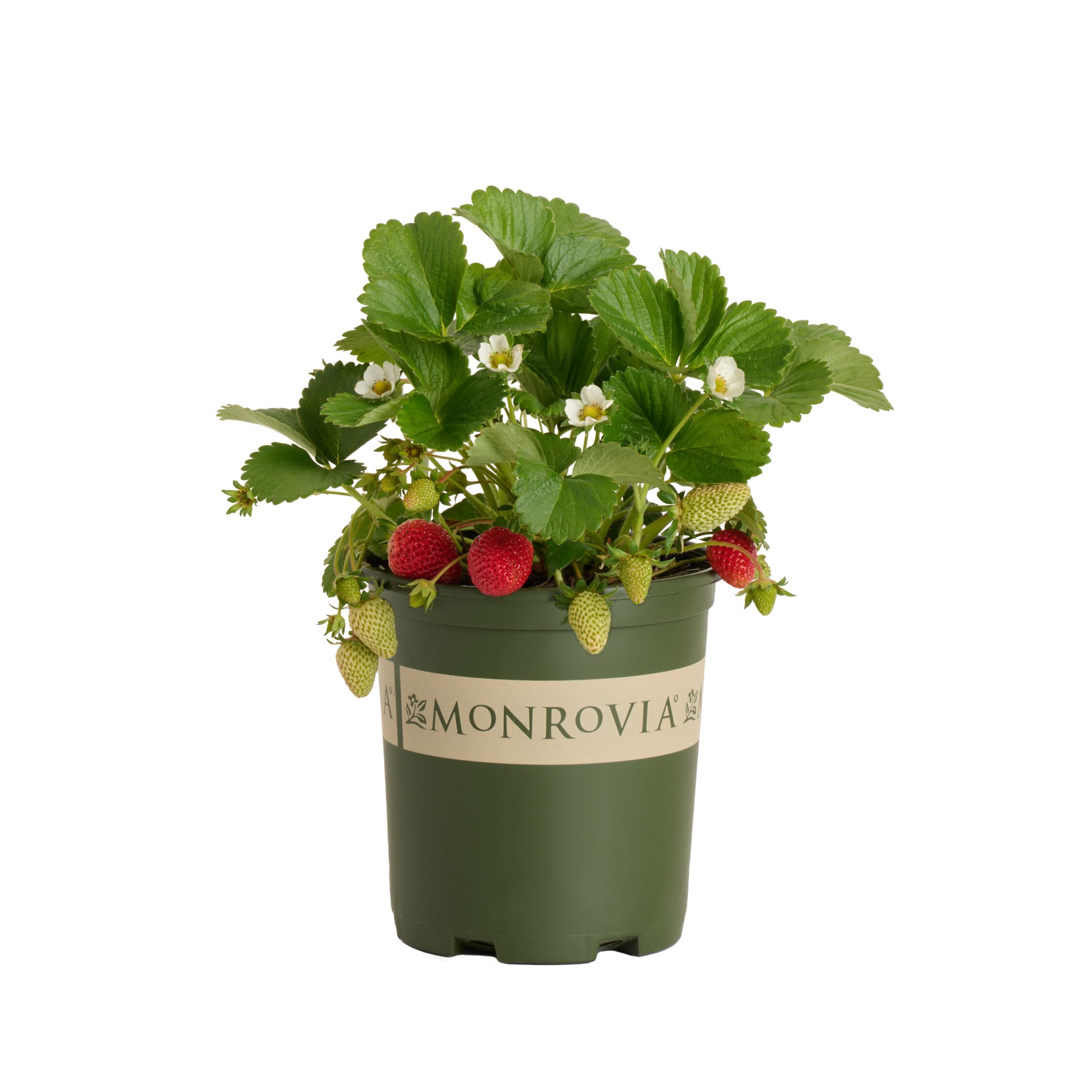Growing strawberries in containers is a rewarding way to enjoy fresh, homegrown berries, even with limited space. This method offers flexibility for gardeners of all experience levels, allowing you to cultivate these sweet fruits on patios, balconies, or any other small spaces. Container-grown strawberries also serve dual purposes: they produce delicious fruit and add visual appeal to your outdoor areas.
Whether you choose June-bearing varieties for an early summer harvest, everbearing types for two harvests a year, or day-neutral for continuous strawberry production throughout the season, success is achievable with the right approach. Below, we'll cover essential tips for selecting appropriate containers, caring for your plants, and maximizing your strawberry yield in a compact setting. So, roll up your sleeves, and let's get started!
Strawberry Care: At a Glance
Running short on time? No problem. Here's a quick overview of the essential aspects of strawberry container care:
- Types: Choose from June-bearing (one big harvest), everbearing (two harvests), or day-neutral (continuous fruiting) varieties.
- Container: Use a pot at least 10-12 inches deep and wide with drainage holes.
- Soil: Fill with high-quality, well-draining potting mix.
- Planting: Keep the crown at or slightly above soil level, and space plants 6-8 inches apart.
- Sunlight: Place in a spot with 6-8 hours of direct sunlight daily.
- Watering: Keep soil consistently moist but not waterlogged. Check moisture every few days.
- Feeding: Apply a balanced liquid fertilizer every 3-4 weeks during the growing season.
- Mulching: Use straw, bark mulch, or pine needles to retain moisture and keep fruit clean.
- Pruning: Trim plants in late summer and remove excess runners.
- Winter Care: Protect from freezing by moving containers or insulating with mulch.
- Replacement: Refresh plants every three years for optimal production.
- Common Issues: Watch for yellowing leaves (overwatering) and curling leaves (mildew or mites), and protect them from birds with netting.
- Harvesting: Pick fully red, slightly soft berries in the morning for the best flavor.
- Storing: Keep unwashed berries in a cool, dry place and use them within a few days.
Why Grow Strawberries in Containers?
If you're on the fence about growing strawberries, we recommend giving container gardening a try. Planting strawberries in pots offers several advantages that might make you wonder why you didn't start sooner.
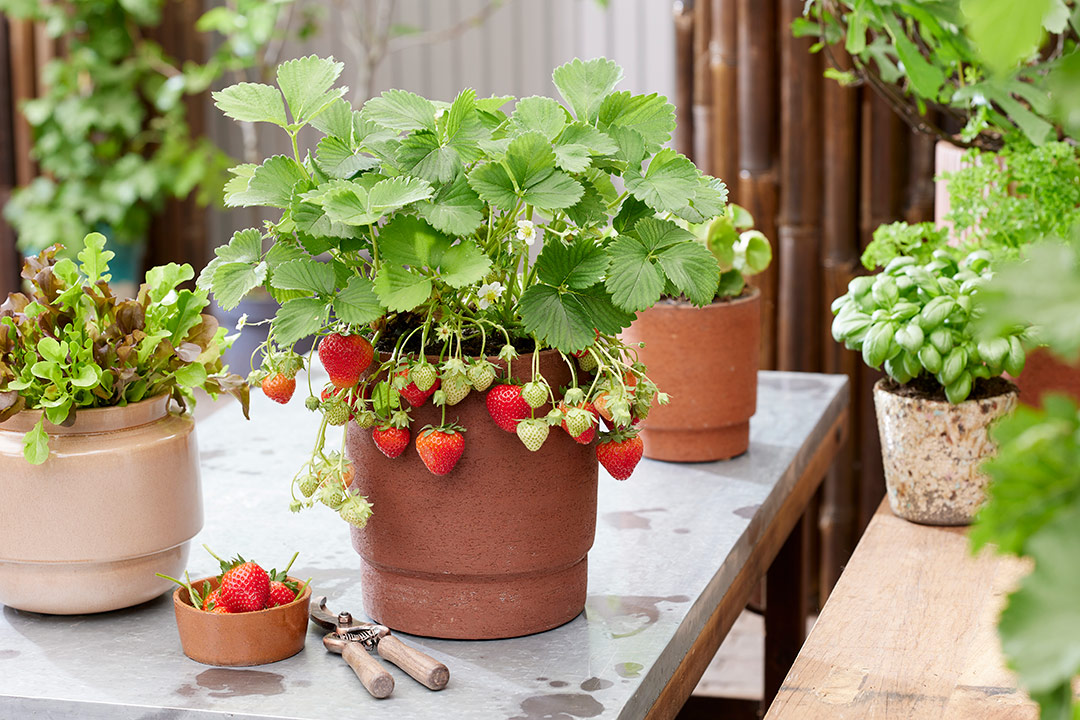
Here's why container-grown strawberries are a fantastic addition to any garden:
- Space-savvy: Even if you only have a small balcony or patio, you can grow these compact plants. Potted strawberries are perfect for urban gardeners or those with limited outdoor space.
- Portable: Strawberry plants produce charming flowers that resemble tiny wild roses. As potted plants, you can move them around to beautify different areas of your outdoor space.
- Convenient Harvesting: Place your containers near your kitchen or outdoor seating area for easy picking. Fresh strawberries for your morning cereal or evening dessert are just an arm's reach away!
- Reduced Bug Damage: Growing strawberries in elevated containers can help protect them from ground-dwelling pests and soil-borne diseases.
- Better Control: Container growing makes managing soil quality, watering, and fertilization easier. You can also protect your berries from unwanted chemicals that might be used on nearby lawns or gardens.
Types of Strawberries
Let's explore the different types of strawberries you can grow in your containers. Knowing these varieties will help you choose the best fit for your gardening goals and expectations.
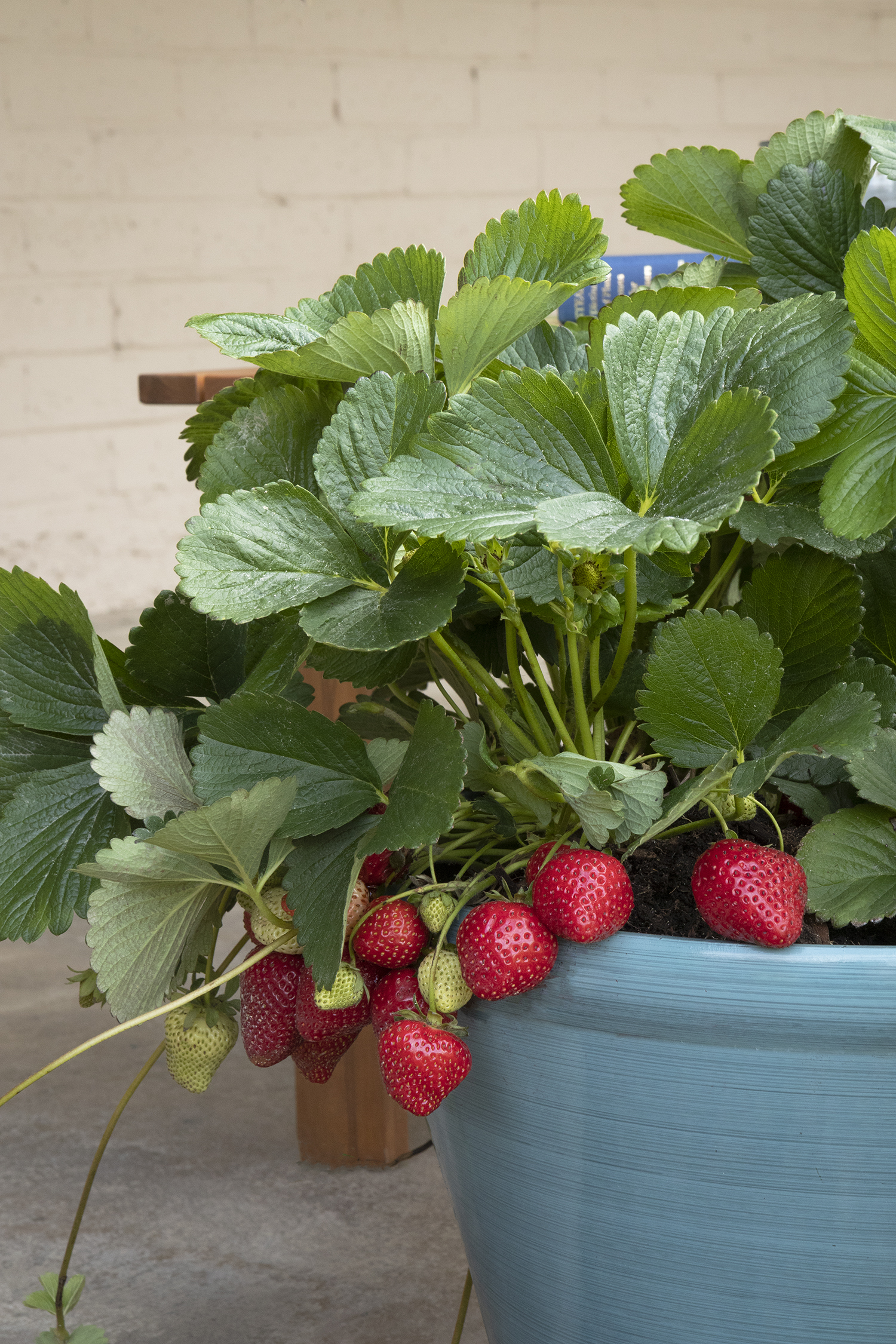
There are three main types of strawberries, each with its own fruiting pattern:
- June-bearing Strawberries: This kind produces one large crop, typically in June. Known for their large, sweet berries, these are perfect for eating fresh or making preserves. They are ideal if you prefer processing a big batch at once.
- Everbearing Strawberries: Yield two yearly harvests, usually in spring and fall. While their berries are smaller, they offer a longer growing season. Popular varieties include the Seascape, Albion, and Eversweet.
- Day-neutral Strawberries: They fruit continuously from spring until the first frost. Their berries are smaller but just as flavorful as those of June-bearing varieties. The San Andreas Strawberry is a reliable variety that provides a steady supply of fresh berries throughout the season.
Remember, each type has its strengths. June-bearing offers a big, delicious harvest all at once, while everbearing and day-neutral provide berries over a longer period. For container growing, everbearing or day-neutral varieties often work well, giving you a longer season to enjoy homegrown treats. Choose the type that best fits your strawberry dreams.
Gathering Your Strawberry Growing Essentials
Here's what you'll need to get started:
- A Home for Your Berries: Choose a container with good drainage. It doesn't have to be fancy—even a repurposed bucket with holes drilled in the bottom will do!
- Nutrient-rich Potting Mix: Your strawberries will thrive in well-draining, fertile soil.
- Strawberry Plants: Container-grown plants from Monrovia® have strong root systems that give you off to a fast start!
- A Trusty Watering Can of Hose Wand: For keeping your plants hydrated and happy.
- A Small Garden Trowel: Perfect for planting and maintaining your strawberry patch.
- Liquid Fertilizer: To give your plants an extra boost of nutrients.
With these simple tools and materials, you'll be all set. Gardening is about enjoying the process, so don't worry if you don't have everything perfect from the start. Half the fun is in learning and growing along with your plants!
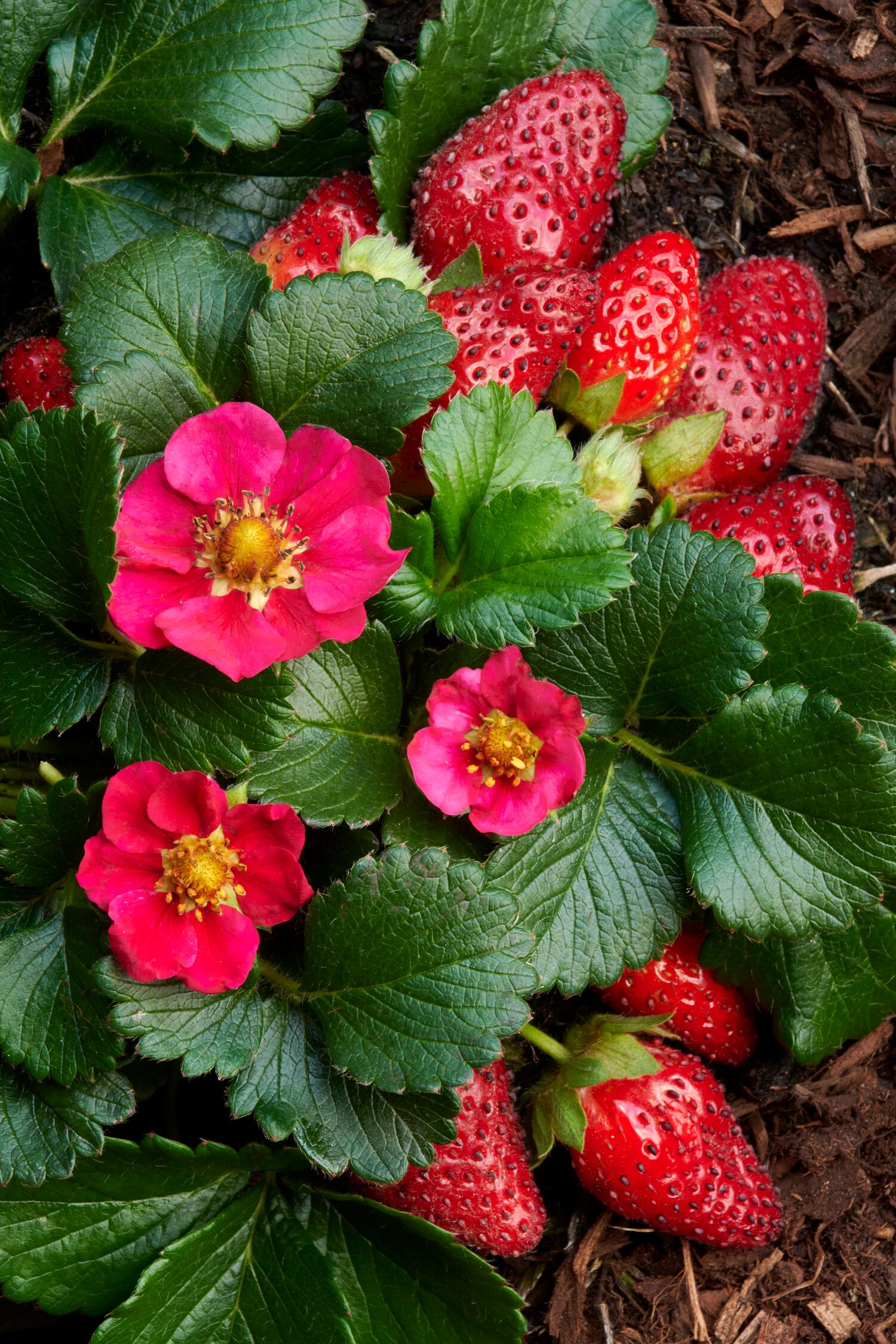
Planting Your Container Strawberries: A Step-by-Step Guide
Now that you've gathered your supplies, it's time to get your hands dirty and start planting. Follow these steps to give your strawberries the best start in their new container home:
- Choose Your Container: Select a pot, window box, or hanging basket at least 10-12 inches deep and wide. Ensure it has drainage holes. Strawberry jars with side holes work great too.
- Prepare the Container: Fill it with a high-quality potting mix. This gives your strawberries the perfect balance of nutrients, moisture retention, and drainage.
- Plant with Care: Place the strawberry so its crown (where the stem meets the roots) is at or slightly above the soil level. Fill with soil around the plant, pressing down as you go to prevent air pockets.
- Space Appropriately: Allow about 6-8 inches between plants for adequate growing room.
- Find the Perfect Spot: Place your container where it will receive 8-12 hours of full sun daily. If light comes from one direction, rotate the pot every few days for even growth. Consider using netting or fencing to protect your plants from curious critters.
With your strawberries now snugly planted in their containers, you're off to a great start. But the journey doesn't end here—proper care is important for a bountiful harvest. In the next few sections, we'll explore the ins and outs of nurturing your container strawberries, from regular maintenance to troubleshooting common issues.
Caring for Your Container Strawberries
Container-grown strawberries need a bit more attention than their in-ground cousins, but you can keep them healthy and productive with these tips.
Watering
Your container strawberries will be thirstier than those in the ground. Check the soil moisture regularly—when the top inch feels dry, it's time to water. Give them a good drink, but avoid waterlogging. Aim for consistently moist, not soggy, soil. During hot spells, you might need to water daily. Remember, containers dry out faster than garden beds!
Mulching
A layer of mulch is your strawberry's best friend in a container. It helps retain moisture, keeps the soil cool, and prevents dirt from splashing onto your berries. Straw, bark or pine needles work great. Just leave some breathing room around the plant's crown to prevent rot.
Feeding
Container strawberries need regular meals to stay happy. Feed them with a balanced, water-soluble fertilizer every 3-4 weeks during the growing season. But easy does it—too much fertilizer can lead to lots of leaves but fewer berries. Cut back on the nitrogen if your plants look lush but aren't fruiting well.
Pruning
Giving your strawberries a trim helps them stay productive and healthy. Keep an eye on those runners —while they look charming, they can steal energy from fruit production. If you notice lots of runners but smaller or fewer berries, it's time for a pruning session. Once your plant has finished fruiting, cut the foliage down to one inch above the soil. This will lead to a fuller, healthy plant next year. Don't be shy with those shears—your plants will reward you with better growth.
Keep an eye out for any yellowing leaves or signs of pests. Container plants are easier to monitor, so you can catch any issues early. With a little TLC, your container strawberries will reward you with sweet berries all season long.
Long-Term Care: Renewing and Protecting Your Container Strawberries
Strawberry plants are productive but short-lived. Here's how to keep your container garden thriving:
- Replace plants every three years when production declines.
- Propagate new plants from runners for a cost-effective refresh.
- Use organic fertilizer when replanting to boost nutrients.
Winter protection is vital for container strawberries:
- Move pots to an unheated garage or under a deck in cold areas.
- If leaving outside, insulate pots with mulch.
- Water sparingly when the soil is very dry.
Tip: The average temp in your area will determine how much winter protection your plants need.
Troubleshooting Your Container Strawberries: Common Issues and Solutions
Even with the best care, strawberries can sometimes face challenges. Here's how to spot and address common problems:
- Curling Leaves: While normal in the morning, persistently curled leaves might indicate powdery mildew or cyclamen mites. For mites, try weekly applications of insecticidal soap. For powdery mildew, apply fungicide and prune affected leaves.
- Yellow Leaves: Often a sign of overwatering. Ensure your container has good drainage and water only when the top inch of soil feels dry.
- Brown Leaves: Could be from overwatering, scorching, or leaf spot. Remove affected leaves and adjust your watering. If a leaf spot is suspected, consider a fungicide treatment.
- Pests: While container growing reduces some pest issues, watch out for birds and small animals. Simple netting can protect your berries.
- Diseases: Gray mold and powdery mildew are common culprits. Prevent this by ensuring good air circulation between plants and using a natural fungicide like neem oil if needed.
Healthy plants are more resistant to problems. Proper care, including well-draining soil, adequate sunlight, and consistent (but not excessive) moisture, goes a long way in preventing issues. Don't be discouraged if you encounter a problem—it's all part of the learning process.
Harvesting and Storing Your Container Strawberries
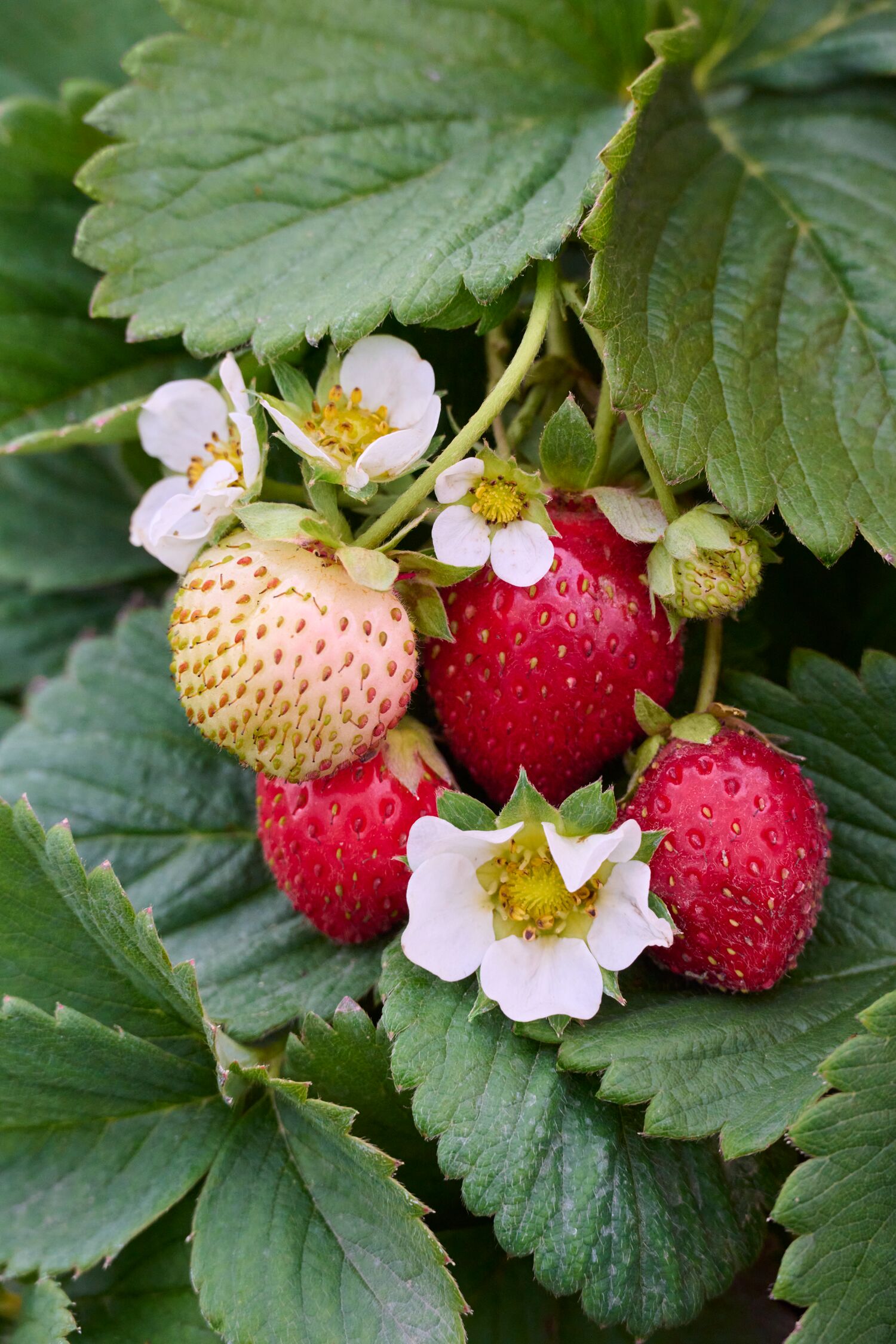
Picking your homegrown strawberries is the sweet reward for all your hard work! Here's how to harvest and store them for maximum enjoyment:
Harvesting
- Pick berries when they're fully red and slightly soft to the touch.
- Gently pull the fruit from the stem to avoid bruising.
- Harvest in the morning for the sweetest flavor.
- Leave the green cap on until you're ready to eat.
Storing
- Keep freshly picked berries dry and cool.
- Remove any damaged or moldy berries.
- Store unwashed in a shallow container lined with paper towels.
- Cover loosely with plastic wrap and refrigerate.
- Enjoy within a few days for the best flavor.
- Wash only when you're ready to eat them.
With these tips, you'll be able to savor the fruits of your labor at their peak freshness. Happy harvesting!
Commonly Asked Questions
How often should I water my container strawberries?
Check the soil moisture every couple of days. Water when the top inch of soil feels dry, which is typically 2-3 times per week. You might need to water daily during hot spells, as containers dry out faster than garden beds.
Can I grow strawberries in a hanging basket?
Absolutely! Hanging baskets are great for strawberries, especially varieties that produce runners. Just ensure the basket is at least 10-12 inches deep and wide and has good drainage. Remember that hanging baskets may need more frequent watering than ground-level containers.
How do I protect my container strawberries in winter?
In colder regions, move pots to a protected area like an unheated garage or under a deck. If you can't move them, insulate the pots with mulch or straw around the sides and top. Water sparingly during winter, only when the soil feels very dry.
Why are my strawberry leaves turning yellow?
Yellow leaves often indicate overwatering. Ensure your container has good drainage and only water when the top inch of soil feels dry. If the problem persists, check for signs of pests or diseases, and consider adjusting your fertilizing routine.
Learn More About Growing Edible Plants Confidently
Sign up for the Grow Beautifully Newsletter. You'll get gardening tips, design ideas, free digital guides, and live webinar invites. Plus, new, exclusive plant information is delivered straight to your inbox twice a month.
- Your Guide to Growing Delicious Strawberries
- Learn How to Plant a Strawberry Hanging Basket in This Video
- Edible Landscape Design: Lessons from an Expert
- Blueberry Care Guide
- Ultimate Guide to Growing Berries
- Plant a Berry Garden for Winter Birds
- Top 10 Drought-Tolerant Edible Plants
- 5 Easy Steps for Growing Grapes
- How to Grow Fig Trees
- Keep Strawberries Fruiting in Late Summer
- Putting Container Planted Berries to Bed
- Grow a Grill Garden





